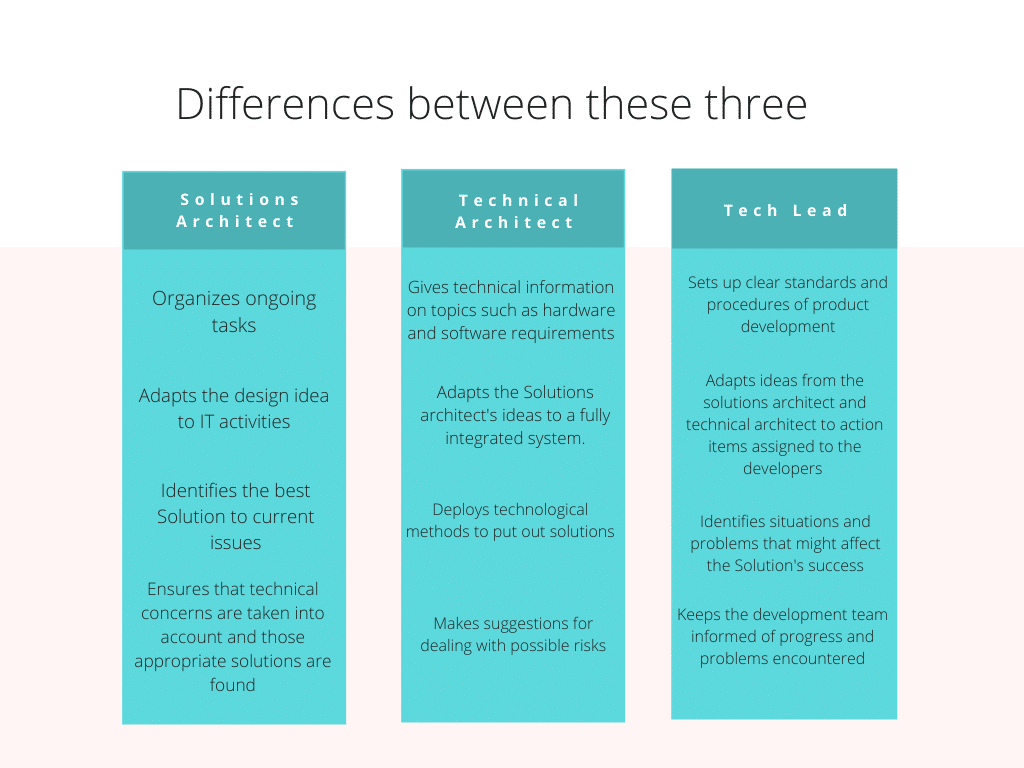When Is it Time to Hire a Solutions Architect?
Who is a solutions architect, what does he do, and how does his knowledge help software development? Before we respond, let us understand how the solution’s architecture influences the development process and where a solution architect comes into play.
As it stands, a solutions architecture guarantees that preliminary design processes are followed, that critical IT procedures are documented, that project progress is tracked, and that it maintains agreement and communication among all stakeholders. According to Scaled Agile’s 2021 definition, a Solution Architect/Engineer is an expert whose job is to define and communicate a shared technical and architectural vision across a “Solution Train” to help ensure the system or Solution under development is fit for its intended purpose.
But an architect does far more than that. To get the complete picture, we’ll go over the roles and responsibilities of a solutions engineer in greater depth and compare the best time to hire a solution architect, technical architect, or team lead.
What Does a Solutions Architect Do?
Cost overruns are one of the most serious consequences of poor IT project management. Estimates will be inaccurate if appropriate structures and planning are not used, and activities will end up costing more than planned. According to a Project Management Institute study from 2017, 14% of IT projects fail. However, that figure reflects the overall number of failures. Of the initiatives that did not fail outright, 31% did not achieve their objectives, 43% surpassed their original costs, and 49% were late.
Therefore, an initial design is required to evaluate a company’s specific needs and comprehend how development teams can meet such demands. This is where a solutions architect comes in.
A solution architect is in charge of the whole infrastructure of the company’s information technology platform. They ensure that the platform fulfills the requirements of the business. Designing processes, documenting critical IT procedures, monitoring project progress, and keeping a security focus are just a few of the key responsibilities of a solutions architect. They must also work with other teams to develop the appropriate systems.
A solutions architect should have at least two years of IT experience and a bachelor’s degree in computer science. Using big data is one of the essential talents to have. Another skill required is understanding architectural methods and frameworks since the solutions architect will need to execute strategies successfully.
Responsibilities of a Solutions Architect
- Designing of the architecture of product system solutions in terms of new components and modifications
- Care for designing solutions that meet security and performance
- Identifying requirements for the hardware, infrastructure, and software environment
- Cooperation with business owners to understand the needs and design the best solutions.
- Identification and management of risk factors related to the adopted architecture and technology
- Collaborate with other architects
- Implement a vision-driven company strategy.
- Make certain that a security emphasis is implemented.
- Collaborate with sales to put innovative ideas into action.
- Investigate new trends and ideas.
- Create procedures that increase the efficiency of your company.
Skills of a Good Solutions Architect
- The ability to rapidly identify issues
- Effective problem-solving abilities
- Excellent communication abilities
- Experience with machine learning Ability to manage several projects at the same time Proven understanding of system design
- Capability to operate successfully as a group
- Ability to self-organize work
- Independence
- Discipline
Solution Architect vs. Technical Architect vs. Team Lead
It is impossible to set, implement, and refresh product development goals to remain relevant to the company without the guidance of an IT architect. While this is correct, it is also necessary to know the various roles that software architects play. Learning about them provides you with the knowledge you need to find the right talents — whether a solution, technical architect, or team lead — as hiring incompetent people or wasting resources for the wrong reasons would be counterproductive.
Who is a Technical Architect
Technical architects introduce fresh and contemporary technology to their business to influence different computer systems. They often collaborate with engineering teams to find answers to technical issues. They usually have a lot of expertise in creating software applications. Technical architects may provide insight into technical initiatives and serve as a reference for other team members.
Technical Architect’s Responsibilities
- Recognize the requirements of the business to create system specifications.
- Plan and develop the structure of a technological solution.
- Communicate system requirements to software development teams.
- Evaluating and selecting suitable software or hardware, as well as suggesting integration techniques
- Oversee assigned programs (e.g., code review) and offer advice to team members.
- Assist with the resolution of technical issues as they occur.
- Ensure the agreed-upon architecture and infrastructure are implemented.
- Address technical problems, thoughts, and recommendations.
- System monitoring ensures that systems fulfill both user requirements and corporate objectives.
Who is a Lead Developer?
While the architect is responsible for the requirements, the lead engineer must agree and give feedback on feasibility, complexity, and implementation specifics. Lead developers have the competence and talents of senior developers. They have extensive professional programming experience and demonstrate subject matter expertise in conceptualizing, planning, and developing software to solve complex problems. A lead developer often leads teams and bridges the gap between the engineering team and other business teams.
Lead Developer’s Responsibilities
- Working directly with key stakeholders to understand business needs and translate this into technical requirements for the development team.
- Technical requirements for features or system design must be planned and documented.
- Designing, developing, and customizing applications to suit the needs of business processes and applications
- Planning and documenting technical specifications for features or system design
- In charge of the development team’s design, development, coding, testing, and debugging of apps.
- Leading code reviews and writing testable, scalable, and efficient code
- Mentoring younger team members and ensuring that they conform to software quality requirements that have been established
So, how do solution architects, tech architects, and lead programmers differ from each other?
- Salary Differences
As seen on PayScale, the average salary of a solutions architect in the US is about $119k/year.
Role Differences

Real-World Examples of When a Solutions Architect is Required
In theory, one of the primary reasons for hiring a solutions architect is to effectively design and build new technology solutions that match its business requirements and bridge the communication gap between technical and non-technical specialists engaged in an IT project. But how does this work in practice?
Let’s look at some instances to help you understand when you may require a solutions architect.
Case 1
Product Design
A retail company buys a wide range of products from all over the world. Their ambition is to broaden their business footprint. To do so, they hire a solutions architect to partner with them on developing a robust and dependable data ingestion pipeline. This pipeline’s goal is to collect various types of data from the acquired companies and departments.
In this project, the solutions architect will be in charge of:
- Building a product design in collaboration with the team
- Making certain that data is collected in real-time.
- Developing algorithms from data analysis
- Presenting the findings of the analysis to stakeholders
Case 2
Product Migration
Another company that wants to transform its offering to a pure SaaS model hires a solutions architect to collaborate with its development team to design the best SaaS solution for their needs. The solutions engineer uses several patterns to design the possible domains of their solutions, including:
- Data isolation and security
- Autoscaling
- Onboarding
- Monitoring
- Metering and billing
As a result, a scalable and resilient solution was developed.
To Sum up
It’s easy to get lost amid the software development life cycle (SDLC) roles and responsibilities, especially if you’re kickstarting your first IT project.
Moreover, software projects are difficult, and they all take careful planning, a talented development team, and collaboration with software architects — both solutions and technical.
You want to ensure that communication among a project’s team members is clear and unbothered. You also want a final solution that meets the business requirements and solves a problem for its users. So, every hand must be on deck.
Having the combined roles of a solutions architect, technical architect, and team lead is vital to oversee the processes’ management effectively. As such, all three positions should be present throughout the software product development process.



